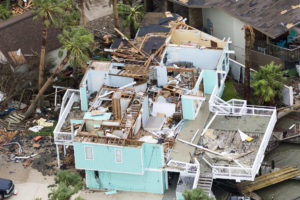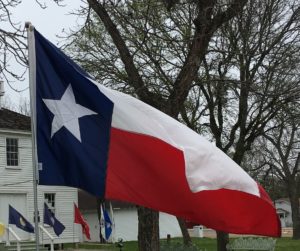Love Letter and Invitation to Serve the Texas Gulf Coast: So Far Away, but So Close to My Heart
By Addie Pfingsten
As a native Texan growing up on the Gulf Coast, preparing for a hurricane was a normal part of life. Every few years our little spot on the coastline was deemed to be in the hurricane zone, so the community would rush around buying boards from the local hardware store, water, bread, and other necessities from Wal-Mart or HEB (the local supermarket), and removing “flyable” objects from the yards.
Citizens would pull out their “hurricane boxes” full of flashlights, candles, and other emergency gear to prepare their homes and businesses for the storm fast approaching. Often the anticipation was the worst part. The media, the warnings, the predictions; it was exhausting to keep up.
The Thousand Year Storm
 Warnings of another storm brewing in the gulf this past August were nothing new, except that I no longer live in Texas and this storm was unlike anything we’d ever seen. It was huge, slow moving, and predicted to stall over the gulf coast for days. I was glued to social media, the Weather Channel, and any other source of information I could find. Even though I no longer reside in Matagorda County, my heart is still there. My parents, my grandmother, my brother, aunts and uncles, nieces and nephews, and cousins all still live in the area.
Warnings of another storm brewing in the gulf this past August were nothing new, except that I no longer live in Texas and this storm was unlike anything we’d ever seen. It was huge, slow moving, and predicted to stall over the gulf coast for days. I was glued to social media, the Weather Channel, and any other source of information I could find. Even though I no longer reside in Matagorda County, my heart is still there. My parents, my grandmother, my brother, aunts and uncles, nieces and nephews, and cousins all still live in the area.
Bay City—the county seat and my hometown, an area full of agriculture and farming—was in the path of the storm. This little town marks the spot where generations past started cattle ranching and cotton farming. It’s a town that has a Rice Festival, in honor of one of their most prized crops. Established right along the Colorado River, Bay City offers great fishing and hunting. The Colorado empties into the Gulf of Mexico, where many make their livelihoods from shrimping and other aquaculture.
What started as a tropical storm named Harvey—aimed towards Corpus Christi—gradually became a monstrous hurricane that would devastate a huge part of Texas, a part I once called home.
I spent most of the days and nights leading up to the landfall worried and stressed. I tried to make sure my family members were making wise choices and getting out of the area. What started as a voluntary evacuation for the county quickly moved to two mandatory evacuations.
Damaged Beyond Recognition
As the eye of Hurricane Harvey made landfall in Rockport I was in disbelief. Rockport is a place I had been many times, an ideal vacation spot with beautiful boats, restaurants, and shopping. I have fond memories of Rockport and friends who live there.
Newscasters reported that the town was left in pieces. This small little coastal town that was so dear to so many was damaged beyond recognition.
Harvey didn’t stop there. With winds howling and torrential rain not ceasing for days, the waters began to rise. Tornadoes spread throughout the eastern part of the state, affecting coastal areas from Rockport to Louisiana. Thousands without electricity and shelter tried to escape the flooding. Most of my relatives and my county amazingly were spared the worst of it, but my aunt’s home flooded and my cousin’s house was destroyed by fire. Everyone along the Gulf Coast knew someone directly affected.
Days later the sun began to shine and the birds began to chirp as the hurricane moved northeast, but the flooding spread as the water levels continued to rise. Life along the Colorado River means the ever-present threat of flooding, but this scale was unprecedented. As Matagorda County called yet another evacuation, the county just north, Wharton, began to feel the effect of the floodwaters as the river crested.
Rising Floodwaters
Downtown Wharton, so close to the river, ended up entirely flooded—the town’s officials did not expect it to spread as far as it did. Wharton was devastated as were the nearby low-lying areas. The floodwaters stranded cattle and horses, destroyed crops, and displaced thousands. Helicopters flew low to deter cattle from straying and help them get to higher ground.
As the days progressed the floodwaters eventually began to recede. Ranchers and farmers jumped in to help each other as livelihoods were at stake. Families came together to clean out each other’s homes. The town jumped in and the real work began.
The cleanup continues and will for years along the Gulf Coast. Ripping out drywall and pulling up flooring to rid homes and businesses of the stench left from Harvey will be an ongoing and mentally and physically exhausting process. When dreams are dashed and lives altered the recovery is long and tedious. Encouragement is greatly needed.
Sharing Christ’s Love in Texas
Now is when I, with my family and friends still working through the aftermath, begin to think about how I can help all the way from Minnesota.
We at Thirst Missions have decided to help people in the small counties in the Gulf Coast of Texas. Since I have the privilege of working for a short-term mission organization that brings 75+ teams per year to share the love of Christ in Alaska, Belize, and England, helping in Texas is a natural fit for us.
We ask that you join us in serving the Gulf Coast of Texas in March or Summer of 2018 and beyond. Please help us to bring encouragement, hard work, and the love of Jesus Christ to those who have had their lives forever altered. May God bless the amazing people in the state of Texas along the Gulf, which is so far away but so close to my heart, in the months and years ahead.
Click here for more information on how your team can go and serve in Texas or register here today.




